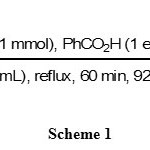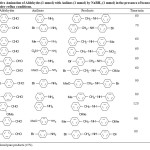NaBH4/PhCO2H: An Efficient system for Reductive Amination of Aldehydes
Nima Mohammadi and Davood Setamdideh*
Department of Chemistry, Faculty of Sciences, Mahabad Branch, Islamic Azad University, Mahabad. Iran. Corresponding Author Email: d.setamdideh@iau-mahabad.ac.ir
DOI : http://dx.doi.org/10.13005/ojc/310476
Article Received on :
Article Accepted on :
Article Published : 23 Oct 2015
NaBH4/PhCO2H system has been used for the reductive amination of a variety of aldehydes with anilines. The reductive amination reactions have been performed within 60-120 min in THF under reflux conditions in high to excellent yields of products (85-95%).
KEYWORDS:NaBH4; PhCO2H; Reductive amination; Aldehydes; Amines
Download this article as:| Copy the following to cite this article: Mohammadi N, Setamdideh D. NaBH4/PhCO2H: An Efficient system for Reductive Amination of Aldehydes. Orient J Chem 2015;31(4). |
| Copy the following to cite this URL: Mohammadi N, Setamdideh D. NaBH4/PhCO2H: An Efficient system for Reductive Amination of Aldehydes. Orient J Chem 2015;31(4). Available from: http://www.orientjchem.org/?p=12111 |
Introduction
Amines can be synthesized from their corresponding of aldehydes. So much method has been used for this purpose such as: the reduction of nitro, cyano, azide, carboxamide compounds or the alkylation of amines. These methods have problems such as: harsh reaction conditions, over alkylation, low chemical selectivity and generally poor yields. Another method is the reductive amination. This reaction has been carried out by sodium borohydride with different reducing system1-2.Previously, we have reported some systems for this achievement3-7.In continuing our efforts for the development of new reducing systems,in this context;we have reported the reductive amination reaction of aldehydes with anilines by NaBH4 in the presence of benzoic acid in THF.
Results and Discussions
The model reaction has been performed by reductive amination of benzaldehyde and aniline. This reaction was carried outwith different molar ratio of the benzaldehyde/aniline/PhCO2H/NaBH4in different solvents for the optimazition reaction conditions. Our experiments have been shown that using 1 eq. of benzoic acid in THF (5 mL) under reflux conditions is the best conditions to complete the reductive amination of benzaldehye (1 mmol) and aniline (1 mmol) to N-benzylaniline. The reductive amination was completed within 60 min with 92% yields of product as shown in scheme 1.
 |
Scheme 1 Click here to View scheme |
A variety of aldehydes and anilines have been used by this reducing system.Experiments have been shown the corresponding secondary amines were obtained in excellent yields (85-95%) within 60-120 min as shown in table 1.The influence of benzoic acid is not clear but we have observed sodium borohydride is slowly decomposed by activated benzoic acid. Consequently, it is liberated hydrogen gas in situ. Thus, the generated molecular hydrogen accelerates the reduction reaction.
Experimental
The products were characterized by their 1H NMR (400 MHz Bruker)or IR (Perkin Elmer FT-IR RXI) and comparison with authentic samples (melting or boiling points). TLC was applied for the purity determination of substrates, products and reaction monitoring over silica gel 60 F254 aluminum sheet.
Reductive Amination of Banzaldehyde and Aniline with NaBH4/Benzoic Acid System (Typical Procedure)
In a round-bottomed flask (10 mL) equipped with a magnetic stirrer, a solution of benzaldehyde (0.106 g, 1 mmol), aniline (0.093 g, 1 mmol) and activated benzoic acid(0.122 g, 1 mmol) was prepared in THF (5 mL). Then the NaBH4 (0.036 g, 1 mmol) was added to the reaction mixture and stirred under reflux conditions. TLC monitored the progress of the reaction (eluent; CCl4/Ether: 5/2). The reaction was filtered after completion within 60 min. Evaporation of the solvent and short column chromatography of the resulting crude material over silica gel (eluent; CCl4/Ether: 5/2) afforded the N-benzylaniline (0.l66 g, 92% yield, Table 1, entry 1).
 |
Table 1: Reductive Amination of Aldehydes (1 mmol) with Anlines (1 mmol) by NaBH4 (1 mmol) in the presence of benzoic acid(1 mmol) in THF (5 mL) under reflux conditions. Click here to View table |
Conclusion
In this context, we have shown that the NaBH4/benzoic acidis convenient system for the reductive amination of a variety of aldehydes and anilines to their corresponding secondary amines. The reduction reactions were accomplished with NaBH4 (1 mmol) and activated benzoic acid (1 mmol) in THF under reflux conditions.High efficiency of the reduction reactions and easy work-up procedure makes as an attractive new protocol for reductive amination of aldehydes.
Acknowledgements
The authors gratefully appreciated the financial support of this work by the research council of Islamic Azad University branch of Mahabad.
References
- Alinezhad, H.;Tollabian, Z.Bull. Korean Chem. Soc.2010, 81, 1927-1930.
- Alinezhad, H.;Tajbakhsh, M.; Mahdavi, N. Synth. Commun.2010,40, 951-956.
- Setamdideh, D.; Sepehraddin . D. J. Mex. Chem. Soc. 2014, 57, 22-25.
- Setamdideh, D.; Hasani, S.; Noori, S. J. Chin. Chem. Soc.2013, 60, 1267-1271.
- Pourhanafi, S.; Setamdideh, D.; Khezri, B. Orient. J. Chem. 2013, 29, 709-712.
- HasanloieTaie, S.; Setamdideh, D. Orient. J. Chem. 2014, 30, 341-344.
- Arefi, H.; Setamdideh, D. Orient. J. Chem. 2014, 30, 299-302.

This work is licensed under a Creative Commons Attribution 4.0 International License.









